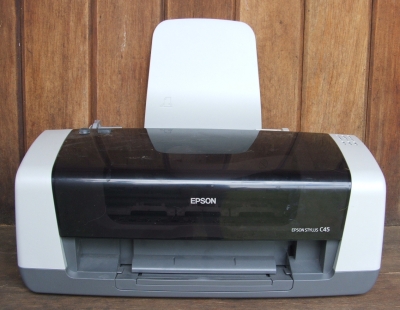
Non-impact printers are generally much quieter than impact printers since they don't physically strike the page. For example, inkjet printers spray tiny drops of ink onto the page, while laser printers use a cylindrical drum that rolls electrically charged ink onto the paper. Both of these methods are non-impact and provide an efficient printing process that produces little sound. The low impact nature of inkjet and laser printers also means they are less likely to need maintenance or repairs than earlier impact printers.
Major Types of Non-impact Printers
1.Laser Printer:
A laser printer is a printer for computers. It uses LED-technology to get small particles of toner from a cartridge onto paper. Very often, this is more economical to use than the ink of inkjet printers. The laser printer was first invented by a team at Xerox in 1969. The first laser printer was called the Xerox 9700.
Process
Laser printing is a process which typically involves seven steps:
- Raster Image Processing: the processor inside the printer converts the data to be printed from whatever format it currently exists in, into a bitmap of the page to be printed - this is then stored in raster image memory.
- Charging: An electrostatic charge is then projected onto a revolving photosensitive drum inside the printer.
- Writing: A laser beam is directed at a rotating polygonal mirror, which redirects the beam onto the photosensitive drum. The rasterized data in memory is now read, and used to control whether the laser is on or off, as the beam sweeps across the drum - where the laser beam strikes the drum the charge is reversed, creating a latent electrical image on the surface.
- Developing: The surface of the drum is then exposed to negatively charged particles of toner, which are attracted to the areas where the laser wrote the latent electrical image. The toner will be repelled by the negative charge on areas of the drum where the laser beam did not strike, and hence remove the charge.
- Transferring: The drum is now rolled over paper, transferring the image from the drum to the paper (to aid in this process there is a positively charged roller behind the paper, which pulls the toner off the drum and onto the paper).
- Fusing: The paper is then passed through a fuser, where rollers provide heat and pressure to bond the toner to the paper.
- Cleaning: An electrically uncharged blade and a discharge lamp remove any toner and all the charge remaining on the drum (this will all happen in one revolution of the drum).

An Inkjet printer is a printer for computers. It uses special ink to print on the paper. Another type of printing technology is the Laser printer. Usually, inkjet printers are used by people who print very little. The ink comes in special ink cartridges, which can be very expensive and uneconomical. Also, the ink in the cartridge may dry up. This means that a new cartridge is needed. Many professionals use inkjet printers to print on very large surfaces (up to 5m width). These printers usually do not use cartridges, but have a continuous supply of ink that could last for a long time. Inkjet printers need special paper. This paper has been treated so that the ink does not smear. Less expensive inkjet printers, which cost a little more than 100 US dollars, are a bargain for users who want to be able to print pages in color. Inkjet printers can be very cheap but the ink can also be rather expensive. An inkjet printer can print between 300 and 720 DPI (Dots Per Inch)
3.Thermal Printer:
Thermal printer is a digital printing process which produces a printed image by selectively heating coated thermochromic paper, or thermal paper as it is commonly known, when the paper passes over the thermal print head. The coating turns black in the areas where it is heated, producing an image. Two-colour direct thermal printers can print both black and an additional colour (often red) by applying heat at two different temperatures.

No comments:
Post a Comment